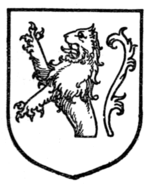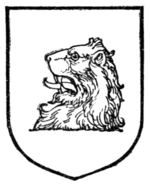as many torteaux, on a bordure of the same twelve lions rampant purpure (Fig. 316).

Fig. 316.—Arms of Richard of Conisburgh, Earl of Cambridge. (From MS. Cott., Julius C. vii.)
Before leaving the lion, the hint may perhaps be usefully conveyed that the temptation to over-elaborate the lion when depicting it heraldically should be carefully avoided. The only result is confusion—the very contrary of the essence of heraldic emblazonment, which was, is, and should be, the method of clear advertisement of identity. Examples of over-elaboration can, however, be found in the past, as will be seen from Fig. 317. This example belongs to the latter half of the fifteenth century, and represents the arms of Bohemia. It is taken from a shield on the "Pulver Turme" at Prague.
Parts of lions are very frequently to be met with, particularly as crests. In fact the most common crest in existence is the demi-lion rampant (Fig. 318). This is the upper half of a lion rampant. It is comparatively seldom found other than rampant and couped, so that the term "a demi-lion," unless otherwise qualified, may always be assumed to be a demi-lion rampant couped. As charges upon the shield three will be found in the arms of Bennet, Earl of Tankerville: "Gules, a bezant between three demi-lions rampant argent."
 |
 |

|
| Fig. 318.—A demi-lion rampant. | Fig. 319.—A demi-lion passant. | Fig. 320.—A lion's head couped. |
The demi-lion may be both guardant and regardant.
Demi-lions rampant and erased are more common as charges than as crests. They are to be found in several Harrison coats of arms.
Demi-lions passant (Fig. 319) are rather unusual, but in addition to the seeming cases in which they occur by dimidiation they are sometimes found, as in the case of the arms of Newman.
